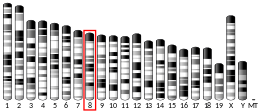| JPH3 |
|---|
|
| Identifiers |
|---|
| Aliases |
JPH3, CAGL237, HDL2, JP-3, JP3, TNRC22, junctophilin 3 |
| External IDs |
MGI: 1891497 HomoloGene: 10762 GeneCards: JPH3 |
| Gene location (Human) |
|---|
 |
| Chr. |
Chromosome 16 (human)[1] |
|
| Band |
16q24.2 |
Start |
87,601,835 bp[1] |
| End |
87,698,156 bp[1] |
|
| Gene location (Mouse) |
|---|
 |
| Chr. |
Chromosome 8 (mouse)[2] |
|
| Band |
8|8 E1 |
Start |
121,729,623 bp[2] |
| End |
121,794,276 bp[2] |
|
RNA expression pattern |
|---|
 |
| More reference expression data |
|
| Gene ontology |
|---|
| Molecular function |
• calcium-release channel activity
• molecular function
|
| Cellular component |
• plasma membrane
• endoplasmic reticulum
• endoplasmic reticulum membrane
• membrane
• junctional sarcoplasmic reticulum membrane
• junctional membrane complex
• integral component of membrane
|
| Biological process |
• regulation of neuronal synaptic plasticity
• release of sequestered calcium ion into cytosol
• calcium ion transport into cytosol
• memory
• learning
• exploration behavior
• locomotion
• neuromuscular process controlling balance
• regulation of ryanodine-sensitive calcium-release channel activity
• regulation of synaptic plasticity
|
Sources:Amigo / QuickGO
|
|
| Orthologs |
|---|
| Species |
Human |
Mouse |
| Entrez |
|
|
| Ensembl |
|
|
| UniProt |
|
|
| RefSeq (mRNA) |
|
|---|
NM_001271604
NM_001271605
NM_020655 |
|
|
| RefSeq (protein) |
|
|---|
NP_001258533
NP_001258534
NP_065706 |
|
|
| Location (UCSC) |
Chr 16: 87.6 – 87.7 Mb |
Chr 8: 121.73 – 121.79 Mb |
PubMed search |
[3] |
[4] |
| Wikidata |
| View/Edit Human |
View/Edit Mouse |
|
Junctophilin-3 is a protein that in humans is encoded by the JPH3 gene.[5][6][7]
‹ The template below (PBB Summary) is being considered for deletion. See templates for discussion to help reach a consensus. ›
Junctional complexes between the plasma membrane and endoplasmic/sarcoplasmic reticulum are a common feature of all excitable cell types and mediate cross talk between cell surface and intracellular ion channels. The protein encoded by this gene is a component of junctional complexes and is composed of a C-terminal hydrophobic segment spanning the endoplasmic/sarcoplasmic reticulum membrane and a remaining cytoplasmic domain that shows specific affinity for the plasma membrane. CAG/CTG repeat expansions at the Huntington's disease (HD)-like 2 locus have been identified in this gene, which is a member of the junctophilin gene family.[7]
References
^ abc GRCh38: Ensembl release 89: ENSG00000154118 - Ensembl, May 2017
^ abc GRCm38: Ensembl release 89: ENSMUSG00000025318 - Ensembl, May 2017
^ "Human PubMed Reference:"..mw-parser-output cite.citation{font-style:inherit}.mw-parser-output .citation q{quotes:"""""""'""'"}.mw-parser-output .citation .cs1-lock-free a{background:url("//upload.wikimedia.org/wikipedia/commons/thumb/6/65/Lock-green.svg/9px-Lock-green.svg.png")no-repeat;background-position:right .1em center}.mw-parser-output .citation .cs1-lock-limited a,.mw-parser-output .citation .cs1-lock-registration a{background:url("//upload.wikimedia.org/wikipedia/commons/thumb/d/d6/Lock-gray-alt-2.svg/9px-Lock-gray-alt-2.svg.png")no-repeat;background-position:right .1em center}.mw-parser-output .citation .cs1-lock-subscription a{background:url("//upload.wikimedia.org/wikipedia/commons/thumb/a/aa/Lock-red-alt-2.svg/9px-Lock-red-alt-2.svg.png")no-repeat;background-position:right .1em center}.mw-parser-output .cs1-subscription,.mw-parser-output .cs1-registration{color:#555}.mw-parser-output .cs1-subscription span,.mw-parser-output .cs1-registration span{border-bottom:1px dotted;cursor:help}.mw-parser-output .cs1-ws-icon a{background:url("//upload.wikimedia.org/wikipedia/commons/thumb/4/4c/Wikisource-logo.svg/12px-Wikisource-logo.svg.png")no-repeat;background-position:right .1em center}.mw-parser-output code.cs1-code{color:inherit;background:inherit;border:inherit;padding:inherit}.mw-parser-output .cs1-hidden-error{display:none;font-size:100%}.mw-parser-output .cs1-visible-error{font-size:100%}.mw-parser-output .cs1-maint{display:none;color:#33aa33;margin-left:0.3em}.mw-parser-output .cs1-subscription,.mw-parser-output .cs1-registration,.mw-parser-output .cs1-format{font-size:95%}.mw-parser-output .cs1-kern-left,.mw-parser-output .cs1-kern-wl-left{padding-left:0.2em}.mw-parser-output .cs1-kern-right,.mw-parser-output .cs1-kern-wl-right{padding-right:0.2em}
^ "Mouse PubMed Reference:".
^ Takeshima H, Komazaki S, Nishi M, Iino M, Kangawa K (Aug 2000). "Junctophilins: a novel family of junctional membrane complex proteins". Mol Cell. 6 (1): 11–22. doi:10.1016/S1097-2765(05)00005-5. PMID 10949023.
^ Nishi M, Mizushima A, Nakagawara K, Takeshima H (Sep 2000). "Characterization of human junctophilin subtype genes". Biochem Biophys Res Commun. 273 (3): 920–7. doi:10.1006/bbrc.2000.3011. PMID 10891348.
^ ab "Entrez Gene: JPH3 junctophilin 3".
External links
- GeneReviews/NCBI/NIH/UW entry on Huntington Disease-Like 2
Further reading
.mw-parser-output .refbegin{font-size:90%;margin-bottom:0.5em}.mw-parser-output .refbegin-hanging-indents>ul{list-style-type:none;margin-left:0}.mw-parser-output .refbegin-hanging-indents>ul>li,.mw-parser-output .refbegin-hanging-indents>dl>dd{margin-left:0;padding-left:3.2em;text-indent:-3.2em;list-style:none}.mw-parser-output .refbegin-100{font-size:100%}
‹ The template below (PBB Further reading) is being considered for deletion. See templates for discussion to help reach a consensus. ›
Margolis RL, Abraham MR, Gatchell SB, et al. (1997). "cDNAs with long CAG trinucleotide repeats from human brain". Hum. Genet. 100 (1): 114–22. doi:10.1007/s004390050476. PMID 9225980.
Olin KL, Potter-Perigo S, Barrett PH, et al. (2001). "Biglycan, a vascular proteoglycan, binds differently to HDL2 and HDL3: role of apoE". Arterioscler. Thromb. Vasc. Biol. 21 (1): 129–35. doi:10.1161/01.ATV.21.1.129. PMID 11145944.
Holmes SE, O'Hearn E, Rosenblatt A, et al. (2001). "A repeat expansion in the gene encoding junctophilin-3 is associated with Huntington disease-like 2". Nat. Genet. 29 (4): 377–8. doi:10.1038/ng760. PMID 11694876.
Stevanin G, Camuzat A, Holmes SE, et al. (2002). "CAG/CTG repeat expansions at the Huntington's disease-like 2 locus are rare in Huntington's disease patients". Neurology. 58 (6): 965–7. doi:10.1212/wnl.58.6.965. PMID 11914418.
Strausberg RL, Feingold EA, Grouse LH, et al. (2003). "Generation and initial analysis of more than 15,000 full-length human and mouse cDNA sequences". Proc. Natl. Acad. Sci. U.S.A. 99 (26): 16899–903. doi:10.1073/pnas.242603899. PMC 139241. PMID 12477932.
Ota T, Suzuki Y, Nishikawa T, et al. (2004). "Complete sequencing and characterization of 21,243 full-length human cDNAs". Nat. Genet. 36 (1): 40–5. doi:10.1038/ng1285. PMID 14702039.
Gerhard DS, Wagner L, Feingold EA, et al. (2004). "The status, quality, and expansion of the NIH full-length cDNA project: the Mammalian Gene Collection (MGC)". Genome Res. 14 (10B): 2121–7. doi:10.1101/gr.2596504. PMC 528928. PMID 15489334.
Grimsby S, Jaensson H, Dubrovska A, et al. (2005). "Proteomics-based identification of proteins interacting with Smad3: SREBP-2 forms a complex with Smad3 and inhibits its transcriptional activity". FEBS Lett. 577 (1–2): 93–100. doi:10.1016/j.febslet.2004.09.069. PMID 15527767.
Ewing RM, Chu P, Elisma F, et al. (2007). "Large-scale mapping of human protein-protein interactions by mass spectrometry". Mol. Syst. Biol. 3 (1): 89. doi:10.1038/msb4100134. PMC 1847948. PMID 17353931.






Comments
Post a Comment